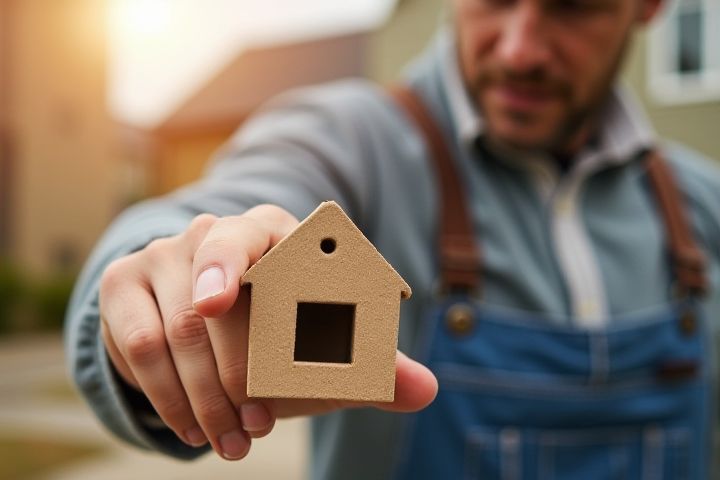
Common house inspection issues include structural problems, such as foundation cracks and sagging beams, which can indicate serious concerns that affect the integrity of the home. Electrical system deficiencies, such as outdated wiring and insufficient grounding, pose safety risks and may require costly upgrades. Plumbing issues, including leaks, rusted pipes, and inadequate water pressure, can lead to water damage and mold growth over time. Roofing problems, like missing shingles or signs of widespread wear, increase the risk of leaks and structural damage. Lastly, pest infestations, particularly termites or rodents, can compromise both the structure and your health, necessitating immediate attention.
What Are Common House Inspection Issues
Roof damage
Roof damage commonly manifests through missing shingles, which can expose the underlayment to moisture and lead to leaks, costing homeowners an average of $300 to $1,000 for repairs. Another frequent issue is roof sagging, often indicative of structural damage or inadequate support, potentially requiring extensive remediation averaging $1,500 to $4,000. Furthermore, granule loss on asphalt shingles can diminish their lifespan, with replacement costs typically ranging from $5,000 to $10,000 for a standard-sized home. Ensuring proper ventilation can prevent moisture buildup, significantly reducing the risk of mold growth and prolonging the roof's integrity.
Foundation cracks
Foundation cracks are a prevalent issue during house inspections, often indicating underlying structural problems. These cracks can vary in size, with significant horizontal or stair-step patterns being particularly concerning, suggesting potential movement or settling of the foundation. Moisture intrusion can exacerbate foundation cracks, leading to mold growth and further damage, which may require remediation costs upwards of $1,500. Addressing these cracks promptly can save homeowners from more extensive repairs, with the average cost of foundation repair ranging from $2,000 to $7,000, depending on the severity and location of the damage.
Plumbing leaks
Plumbing leaks are a prevalent issue in house inspections, often resulting in significant water damage and mold growth. Home inspectors typically identify leaks around fixtures, pipes, and appliances, with common problem areas including basements, kitchens, and bathrooms. In fact, approximately 14% of all water usage in homes can be attributed to leaks, highlighting their impact on water bills and conservation efforts. Ensuring regular maintenance and quick repairs can save homeowners from costly repairs, with average leak repairs costing between $150 to $350 depending on severity and location.
Electrical system faults
Common house inspection issues often arise from electrical system faults, which can pose serious safety hazards. Approximately 51,000 electrical fires occur annually in the U.S., primarily due to faulty wiring and outdated circuit breakers. Your home may have improper grounding, which increases the risk of shock and fire, or overloaded circuits that cannot handle the demand of modern appliances. Additionally, outdated or insufficient electrical panels can lead to frequent tripping and insufficient power supply, necessitating upgrades for safety and efficiency.
HVAC inefficiencies
Common house inspection issues often highlight HVAC inefficiencies that can lead to increased energy costs and reduced comfort. Many systems may exhibit inadequate airflow due to clogged filters or ductwork obstructions, compromising the unit's performance. Additionally, failing to maintain appropriate refrigerant levels can result in diminished cooling capacity and possible compressor damage. Regular maintenance is essential for ensuring your HVAC system operates efficiently, prolonging its lifespan and enhancing indoor air quality.
Mold and mildew presence
Common house inspection issues often reveal mold and mildew presence, particularly in areas with high humidity. Around 70% of homes in humid climates experience some level of mold growth, which can lead to health problems if left untreated. Mold thrives in damp environments, with 24% of all indoor air quality complaints attributed to mold spores. To ensure safety, you should prioritize regular inspections in basements, bathrooms, and kitchens, where moisture tends to accumulate.
Pest infestations
Pest infestations are a significant concern during house inspections, with common culprits including termites, rodents, and cockroaches. Termites alone cause structural damage amounting to approximately $5 billion annually in the United States, underscoring the importance of identifying these pests early. Rodent infestations can lead to serious health risks, as they are known carriers of diseases such as hantavirus and salmonella, which can affect your well-being. Detecting signs of pests, such as droppings, nests, or weakened wooden structures, is crucial to ensuring your future home is safe and healthy.
Poor insulation
Poor insulation is a prevalent house inspection issue that can lead to significant energy inefficiencies, causing heating and cooling systems to work harder and increasing utility bills by 10% to 50%. Inadequate insulation in attics, walls, or basements often results in fluctuating indoor temperatures, creating discomfort and potential health risks from moisture accumulation and mold growth. Many homes may have outdated insulation materials, such as fiberglass batt or cellulose, which lose effectiveness over time, with R-values typically ranging between 3.0 to 4.0 per inch. Ensuring proper insulation can enhance your home's energy efficiency, ultimately improving overall living conditions and increasing property value by approximately 5% to 10%.
Water drainage problems
Water drainage problems frequently emerge during house inspections as significant concerns that can lead to extensive structural damage. Common issues include improper grading around the foundation, which can cause rainwater to accumulate near the base of the home, increasing the risk of basement flooding and foundation cracks. Blocked or inadequately sized gutters and downspouts can also exacerbate drainage problems by overflowing and directing water improperly. Addressing these drainage problems early can protect your property from costly repairs and ensure a safe living environment.
Window and door issues
Common house inspection issues often center around window and door problems that can significantly impact energy efficiency and security. For instance, improperly sealed or damaged window frames may lead to air leaks, increasing heating and cooling costs by up to 30%. Additionally, doors that do not close properly may allow moisture intrusion, potentially resulting in mold growth and structural damage. Regular maintenance and inspection of weather stripping and locks can ensure optimal performance and durability for your home.
